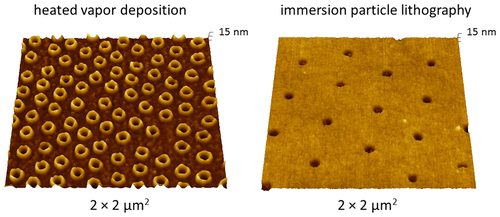当前位置:
X-MOL 学术
›
J. Chem. Educ.
›
论文详情
Our official English website, www.x-mol.net, welcomes your
feedback! (Note: you will need to create a separate account there.)
Preparation of Octadecyltrichlorosilane Nanopatterns Using Particle Lithography: An Atomic Force Microscopy Laboratory
Journal of Chemical Education ( IF 2.5 ) Pub Date : 2017-12-29 00:00:00 , DOI: 10.1021/acs.jchemed.7b00158 Zachary L. Highland 1 , ChaMarra K. Saner 2 , Jayne C. Garno 1
Journal of Chemical Education ( IF 2.5 ) Pub Date : 2017-12-29 00:00:00 , DOI: 10.1021/acs.jchemed.7b00158 Zachary L. Highland 1 , ChaMarra K. Saner 2 , Jayne C. Garno 1
Affiliation

|
Experiments are described that involve undergraduates learning concepts of nanoscience and chemistry. Students prepare nanopatterns of organosilane films using protocols of particle lithography. A few basic techniques are needed to prepare samples, such as centrifuging, mixing, heating, and drying. Students obtain hands-on skills with nanoscale imaging using an atomic force microscope (AFM) when they learn to characterize samples. Designed surfaces are made using a surface mask of latex or silica spheres to generate nanopatterns of organosilanes. An organic thin film is applied to the substrate using steps of either heated vapor deposition or immersion in solution. The steps for preparing samples are not complicated; however, the nanostructures that are produced by particle lithography are exquisitely regular in geometry and surface arrangement. At the molecular level, two types of sample morphology can be made depending on the step for depositing organosilanes. Ring-shaped nanostructures are produced with heated vapor deposition through a particle mask, and nanoholes are produced within a matrix film using immersion of masked substrates. Experience with advanced AFM instrumentation is obtained for data acquisition, digital image processing, and analysis. Skills with chemical analysis are gained with bench methods of sample preparation. Concepts such as the organization of molecules on surfaces and molecular self-assembly are demonstrated with the visualization of nanopatterns prepared by students. Experiments with particle lithography can be used as a laboratory module or for undergraduate research projects, and are suitable for students with a multidisciplinary science background.
中文翻译:

使用粒子光刻技术制备十八烷基三氯硅烷纳米图案:原子力显微镜实验室
描述了涉及大学生学习纳米科学和化学概念的实验。学生使用粒子光刻技术制备有机硅烷膜的纳米图案。需要一些基本技术来制备样品,例如离心,混合,加热和干燥。当学生学习表征样品时,他们将使用原子力显微镜(AFM)获得纳米级成像的动手技能。使用乳胶或二氧化硅球的表面掩模制作设计的表面,以生成有机硅烷的纳米图案。使用加热气相沉积或浸入溶液中的步骤将有机薄膜施加到基底上。制备样品的步骤并不复杂;然而,通过粒子光刻技术产生的纳米结构在几何形状和表面排列上非常规则。在分子水平上,取决于沉积有机硅烷的步骤,可以制成两种类型的样品形态。环形纳米结构是通过加热通过颗粒掩膜的气相沉积而产生的,而纳米孔是通过掩膜基板的浸入在基体膜内产生的。获得了用于数据采集,数字图像处理和分析的先进AFM仪器的经验。通过样品前处理方法可以获得化学分析技能。通过学生准备的纳米图案的可视化展示了诸如分子在表面上的组织和分子自组装的概念。粒子光刻技术可以用作实验室模块或用于本科生研究项目,并且适合具有多学科科学背景的学生。
更新日期:2017-12-29
中文翻译:

使用粒子光刻技术制备十八烷基三氯硅烷纳米图案:原子力显微镜实验室
描述了涉及大学生学习纳米科学和化学概念的实验。学生使用粒子光刻技术制备有机硅烷膜的纳米图案。需要一些基本技术来制备样品,例如离心,混合,加热和干燥。当学生学习表征样品时,他们将使用原子力显微镜(AFM)获得纳米级成像的动手技能。使用乳胶或二氧化硅球的表面掩模制作设计的表面,以生成有机硅烷的纳米图案。使用加热气相沉积或浸入溶液中的步骤将有机薄膜施加到基底上。制备样品的步骤并不复杂;然而,通过粒子光刻技术产生的纳米结构在几何形状和表面排列上非常规则。在分子水平上,取决于沉积有机硅烷的步骤,可以制成两种类型的样品形态。环形纳米结构是通过加热通过颗粒掩膜的气相沉积而产生的,而纳米孔是通过掩膜基板的浸入在基体膜内产生的。获得了用于数据采集,数字图像处理和分析的先进AFM仪器的经验。通过样品前处理方法可以获得化学分析技能。通过学生准备的纳米图案的可视化展示了诸如分子在表面上的组织和分子自组装的概念。粒子光刻技术可以用作实验室模块或用于本科生研究项目,并且适合具有多学科科学背景的学生。







































 京公网安备 11010802027423号
京公网安备 11010802027423号